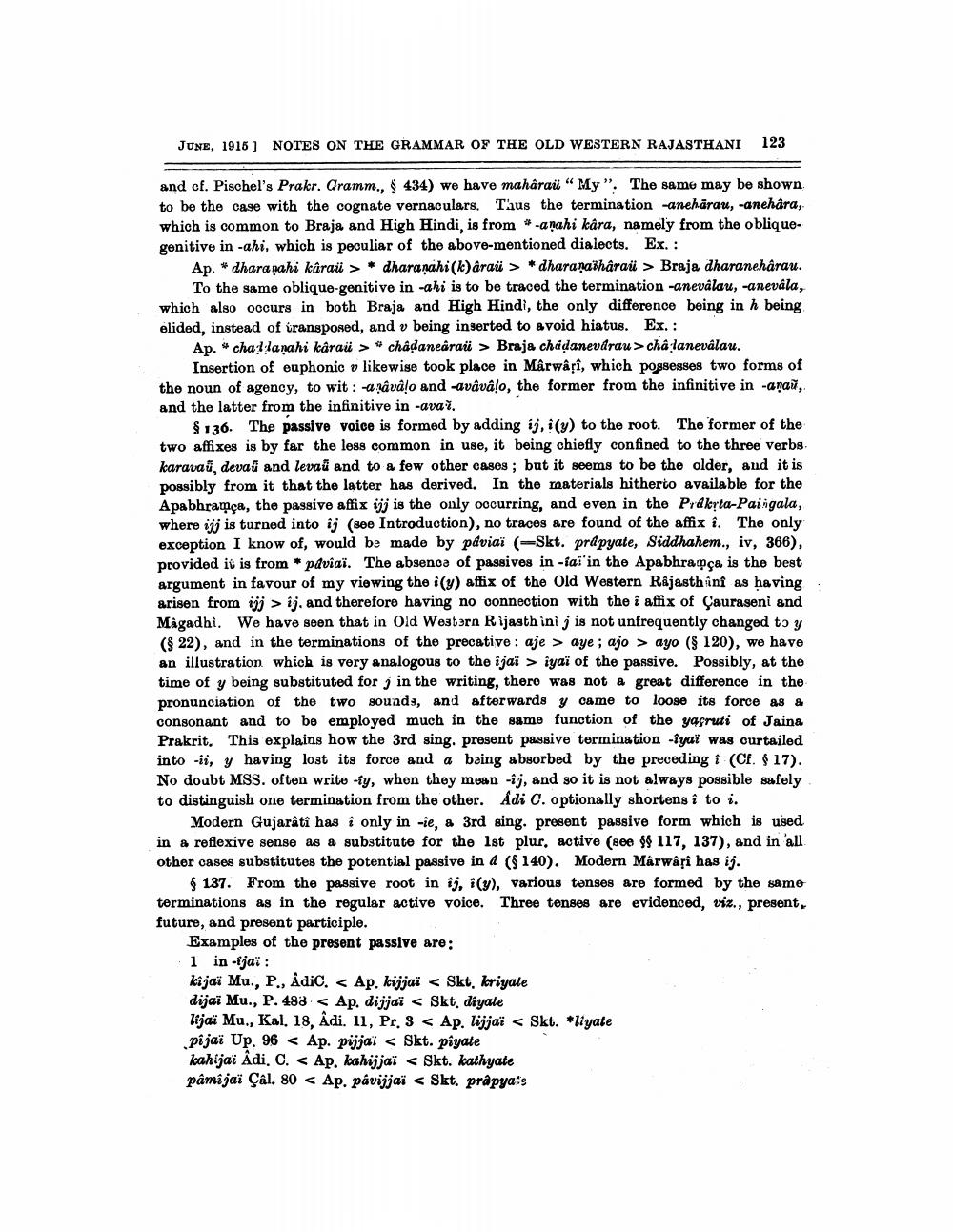________________
JUNE, 1916 ] NOTES ON THE GRAMMAR OF THE OLD WESTERN RAJASTHANI 123
and cf. Pischel's Prakr. Qramm., 434) we have maharaü "My". The same may be shown to be the case with the cognate vernaculars. Tus the termination -anehärau, -anehâra, which is common to Braja and High Hindi, is from * -anahi kâra, namely from the obliquegenitive in -ahi, which is peculiar of the above-mentioned dialects. Ex.:
Ap. * dharanahi kârai > * dharanahi(k)araü > *dharañaðhârau > Braja dharaneharau.
To the same oblique-genitive in -ahi is to be traced the termination -aneválau, -anevala, which also occurs in both Braja and High Hindi, the only difference being in h being elided, instead of transposed, and v being inserted to avoid hiatus. Ex.:
Ap. challanahi kâraii > chádaneâraü > Braja chádanevdrau > chalanevålau.
Insertion of euphonic v likewise took place in Mârwârî, which possesses two forms of the noun of agency, to wit: a râvâļo and avava!o, the former from the infinitive in -anaū, and the latter from the infinitive in -avai.
$ 136. The passive voice is formed by adding ij, (y) to the root. The former of the two affixes is by far the less common in use, it being chiefly confined to the three verbs karavau, devau and leval and to a few other cases; but it seems to be the older, and it is possibly from it that the latter has derived. In the materials hitherto available for the Apabhramça, the passive affix jj is the only occurring, and even in the Prakrta-Pai gala, where ijj is turnod into ij (800 Introduction), no traces are found of the affix i. The only exception I know of, would be made by paviai (-Skt. prapyate, Siddhahem., iv, 366), provided it is from paviai. The absence of passives in -iai'in the Apabhramca is the best argument in favour of my viewing the i(y) affix of the Old Western Rajasthini as having arisen from üj > ij. and therefore having no connection with the i affix of Sauraseni and Magadhi. We have seen that in Old Western Rijasth ini j is not unfrequently changed to y ($ 22), and in the terminations of the precative : aje > aye ; ajo > ayo ($ 120), we have an illustration which is very analogous to the ijaż > iyaï of the passive. Possibly, at the time of y being substituted for j in the writing, there was not a great difference in the pronunciation of the two souads, and afterwards y came to loose its force 88 & consonant and to be employed much in the same function of the yasruti of Jaina Prakrit. This explains how the 3rd sing. present passive termination -iyai was curtailed into -ii, y having lost its force and a baing absorbed by the preceding i (CF. 17). No doubt MSS. often write-fy, when they mean -ij, and so it is not always possible safely to distinguish one termination from the other. Adi C. optionally shortens i to i.
Modern Gujarâtî has i only in -ie, & 3rd sing. present passive form which is used in a reflexive sense as a substitute for the 1st plur, active (860 9 117, 137), and in all other cases substitutes the potential passive in a ($ 140). Modern Marwari has ij.
$ 137. From the passive root in ij, i(y), various tenses are formed by the same terminations as in the regular active voice. Three tenses are evidenced, viz., present, future, and present participle.
Examples of the present passive are: :1 in -ijai:
kijaż Mu., P., &dic. < Ap. kijjač < Skt, kriyate dijai Mu., P. 488 < Ap, dijjai < Skt, diyate lijaï Mu., Kal. 18. Âdi. 11, Pr. 3 < Ap. lijai < Skt. *liyate pijač Up. 96 < Ap. pijjai < Skt. piyate kahijai Âdi. C. < Ap. lahijjai < Skt. kathyate pamijai Çal. 80 < Ap. pávijjai < Skt. prapyas




